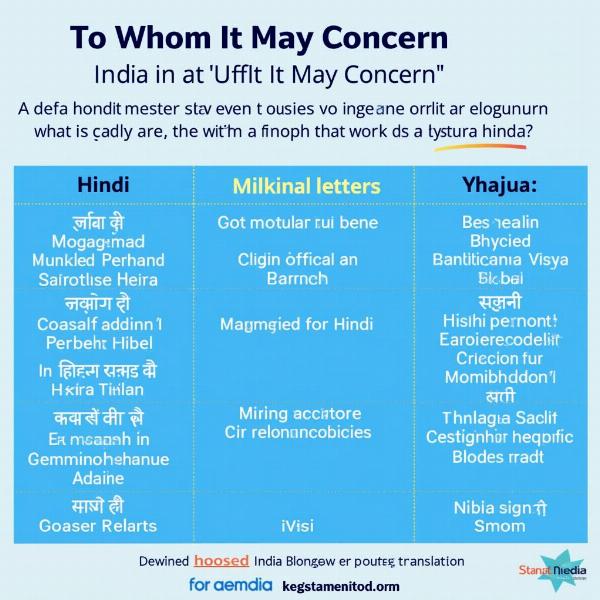“To Whom It May Concern” is a common English phrase used in formal letters when the recipient’s name is unknown. Understanding its meaning and appropriate Hindi equivalents is crucial for effective communication, especially in business and official contexts. This article will explore various ways to express “To Whom It May Concern” in Hindi, considering cultural nuances and the specific situations where each translation is most appropriate.
Different Ways to Say “To Whom It May Concern” in Hindi
While there isn’t a single perfect translation, several options convey the intended meaning effectively. Choosing the right one depends on the formality of the situation and the relationship between the sender and the intended recipient.
-
प्रबंधक महोदय/महोदया (Pramāndhak Mahodaya/Mahodaya): This translates to “Respected Manager” and is suitable when addressing a company or organization without knowing a specific contact person. It’s a respectful and formal option.
-
संबंधित अधिकारी (Sambandhit Adhikārī): Meaning “Concerned Authority,” this is suitable for official correspondence, especially when addressing government departments or agencies.
-
जिसे यह प्रेषित किया जा सकता है (Jise Yah Presit Kiya Ja Sakta Hai): This literally translates to “To whom it may be sent.” While accurate, it can sound slightly awkward in some situations. It’s best used when no other options seem appropriate.
-
यथास्थान (Yathāsthān): This is a more concise and formal option, often used in official or legal documents. It indicates that the letter should be delivered to the appropriate place or authority.
 Hindi Translation of "To Whom It May Concern"
Hindi Translation of "To Whom It May Concern"
When to Use Which Translation
Understanding the context is crucial for selecting the right Hindi equivalent. Using Pramāndhak Mahodaya/Mahodaya would be appropriate when applying for a job without a specific contact person. However, if writing to a government office, Sambandhit Adhikārī is more suitable. For very formal legal documents, Yathāsthān is the preferred option.
Understanding the Cultural Context
Indian culture places a strong emphasis on respect and formality, especially in professional settings. Using the correct salutation shows consideration and can significantly impact how your communication is received. dear concern meaning in hindi
Examples of “To Whom It May Concern” in Hindi Sentences
-
प्रबंधक महोदय/महोदया, मैं इस पत्र के माध्यम से नौकरी के लिए आवेदन कर रहा/रही हूँ। (Pramāndhak Mahodaya/Mahodaya, main is patr ke madhyam se naukri ke liye aavedan kar raha/rahi hun.) (Respected Manager, I am applying for a job through this letter.)
-
संबंधित अधिकारी, कृपया मेरी शिकायत पर ध्यान दें। (Sambandhit Adhikārī, kripya meri shikayat par dhyan den.) (Concerned Authority, please consider my complaint.)
Beyond “To Whom It May Concern”: More Precise Alternatives
While “To Whom It May Concern” is widely used, sometimes it’s better to be more specific. If you can find even a general title or department, addressing the letter to that will demonstrate greater effort and professionalism. For instance, instead of “To Whom It May Concern,” consider “Hiring Manager” or “Human Resources Department.” This shows you’ve taken the time to research and tailor your communication. whom ka hindi meaning
Conclusion
Choosing the right Hindi equivalent for “To Whom It May Concern” depends heavily on the context and your desired level of formality. Using the appropriate phrase shows respect and professionalism, enhancing your communication’s effectiveness. By understanding the nuances of these translations, you can navigate formal correspondence in Hindi with confidence and cultural sensitivity. Remember to consider the specific situation and choose the option that best conveys your message while maintaining respectful communication. The correct translation can make a substantial difference in how your correspondence is received.
FAQ
-
When should I avoid using “To Whom It May Concern” in English and its Hindi equivalents? When you know the recipient’s name, always use it. It personalizes the communication and shows respect.
-
Is there a Hindi equivalent for “Dear Sir/Madam”? Yes, you can use “आदरणीय महोदय/महोदया” (Ādarṇīya Mahodaya/Mahodaya).
-
Which is the most formal option for official correspondence? Yathāsthān is typically the most formal and suitable for legal or official documents.
-
Can I use these translations in emails? Yes, but consider the overall tone of the email. If it’s informal, a slightly less formal salutation might be appropriate.
-
What if I’m unsure which translation to use? When in doubt, opt for Sambandhit Adhikārī as it’s a relatively safe and respectful option for various formal situations. urologist and andrologist meaning in hindi
-
Is it always necessary to be formal in Hindi correspondence? While formality is generally appreciated, the level of formality can depend on the relationship and the specific context.
-
Where can I find more information about Hindi business etiquette? Numerous resources, both online and offline, offer guidance on Hindi business communication and cultural etiquette.
Meaning-Hindi.in is your one-stop solution for all your Hindi translation needs. We offer a wide range of professional translation services, including business and commercial document translation, certified and legal document translation, technical and user manual translation, website and localization services, educational and academic document translation, express translation, and specialized industry translation. Contact us today for accurate, culturally sensitive, and timely Hindi translations to ensure your message is communicated effectively. Email: [email protected], Phone: +91 11-4502-7584. Meaning-Hindi.in will help you bridge the language gap and connect with your target audience in India.